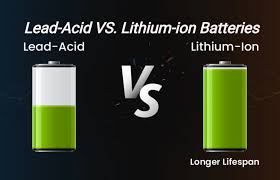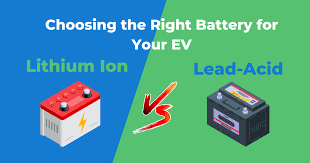When choosing a battery for an e-bike, understanding the advantages and disadvantages of lithium-ion and lead-acid batteries is crucial. Both battery types have unique characteristics that make them suitable for different applications. Below is a detailed comparison of their pros and cons.

Lithium-Ion Batteries
Advantages
- High Energy Density
Lithium-ion batteries have a much higher energy density compared to lead-acid batteries. This means they can store more energy in a smaller, lighter package, making them ideal for e-bikes where weight and size are critical factors. - Lightweight
Lithium-ion batteries are significantly lighter than lead-acid batteries, often weighing 50–60% less. This improves the overall performance, handling, and portability of the e-bike. - Longer Lifespan
These batteries typically last between 500 and 2,000 charge cycles depending on the specific type (e.g., LiFePO4 lasts longer). This translates to several years of use with proper maintenance. - Fast Charging
Lithium-ion batteries charge faster than lead-acid batteries, often taking only 3-4 hours to reach full capacity compared to 8-10 hours for lead-acid. - Low Maintenance
They require minimal maintenance as they do not need periodic electrolyte refills or venting like lead-acid batteries. - Higher Depth of Discharge (DoD)
Lithium-ion batteries can be discharged up to 85-100% without significant damage, allowing users to utilize more of their stored energy per cycle. - Environmentally Friendly
They contain fewer toxic materials compared to lead-acid batteries and are easier to recycle responsibly.
Disadvantages
- High Cost
Lithium-ion batteries are significantly more expensive upfront than lead-acid alternatives, often costing $300-$500 or more depending on capacity and voltage. - Temperature Sensitivity
Performance can degrade in extreme temperatures (both hot and cold), which may affect range and lifespan if not managed properly. - Fire Risk
Although rare with modern safety features like Battery Management Systems (BMS), lithium-ion batteries can overheat or catch fire under extreme conditions such as overcharging or physical damage. - Theft Risk
Due to their high value, lithium-ion batteries are attractive targets for theft when left unattended on an e-bike in public spaces.
Lead-Acid Batteries
Advantages
- Low Cost
Lead-acid batteries are much cheaper upfront compared to lithium-ion options, making them appealing for budget-conscious buyers or entry-level e-bikes. - High Power Output Potential
Lead-acid batteries can deliver high currents efficiently, which may be beneficial for certain high-power applications like heavy-duty e-tricycles or cargo bikes. - Stable Chemistry
The chemical composition of lead acid makes it less prone to spontaneous combustion or thermal runaway compared to lithium-based chemistries. - Widely Available
These batteries are easy to source from local retailers due to their widespread use in various industries beyond e-bikes (e.g., automotive).
Disadvantages
- Heavy Weight
Lead-acid batteries are extremely heavy—often three times heavier than equivalent lithium-ion packs—negatively impacting bike handling, portability, and range efficiency. - Shorter Lifespan
Typically lasting only 200-500 charge cycles under normal usage conditions, they require frequent replacements compared to lithium-ion options. - Low Energy Density
Their lower energy density means they store less power per unit weight/volume, limiting the range of an e-bike unless larger packs are used (which adds even more weight). - Long Charging Times
Lead-acid batteries take significantly longer to charge—upwards of 8-10 hours—compared to lithium-ion alternatives that charge in just a few hours. - Maintenance Requirements
Sealed Lead Acid (SLA) models require regular maintenance, such as checking electrolyte levels or ensuring proper ventilation during charging, due to gas release risks like hydrogen buildup - Environmental Concerns Containing hazardous materials like lead and sulfuric acid makes disposal challenging; improper handling can harm ecosystems

Summary Comparison Table
| Feature | Lithium-Ion Batteries | Lead-Acid Batteries |
|---|---|---|
| Energy Density | High | Low |
| Weight | Lightweight | Heavy |
| Lifespan | Long (500–2000 cycles) | Short (200–500 cycles) |
| Charging Time | Fast (3–4 hours) | Slow (8–10 hours) |
| Maintenance | Minimal | Regular maintenance required |
| Cost | Expensive | Affordable |
| Environmental Impact | Less toxic; easier recycling | Hazardous materials; difficult disposal |
Conclusion
In most cases, lithium-ion is the superior choice for e-bikes due to its lightweight design, higher energy density, longer lifespan, faster charging times, and low maintenance requirements despite its higher cost upfront.
However, lead-acid may still be suitable for budget-conscious users or specific applications where cost savings outweigh performance considerations—such as short-range commutes or testing new setups before committing fully.








